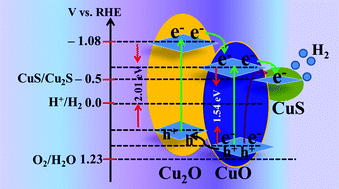A highly stable CuS and CuS–Pt modified Cu2O/CuO heterostructure as an efficient photocathode for the hydrogen evolution reaction†
Abstract
A Cu2O/CuO heterostructure modified with CuS is proposed as a highly promising and stable photocathode for solar hydrogen production. The Cu2O/CuO/CuS heterostructure was synthesized by in situ growth of Cu2O/CuO via simple electrodeposition of Cu film followed by annealing in air, and then the surfaces of the heterostructure were sequentially modified by loading CuS via a successive ion layer adsorption and reaction (SILAR) approach. Experimental evidence, including Raman, XANES/EXAFS and XPS spectra, is presented for the interfacial reaction between CuS and Cu2O/CuO. The optimized Cu2O/CuO/CuS photocathode provides a remarkably enhanced photocurrent density of −5.4 mA cm−2 (i.e. >2.5 times than that of bare Cu2O/CuO) at 0 V vs. RHE under standard AM 1.5 light illumination. Due to the bicatalytic effects in suppressing electron–hole recombination, a further increase in photocurrent density to −5.7 mA cm−2 was noticed after decorating the Cu2O/CuO surface with both CuS and Pt. To the best of our knowledge, this is the highest performance yet reported for a cocatalyst modified Cu2O/CuO photoelectrode for solar water splitting. More importantly, the Cu2O/CuO heterostructure modified with optimum CuS afforded an impressive solar conversion efficiency of ABPE% = 3.6%, which is a greater than fourfold increase compared to the bare Cu2O/CuO. The stability of the bare Cu2O/CuO photocathode showed about a 44% decrease in initial photocurrent density within 1 h, whereas 85% and 92% of the initial photocurrent was maintained after 1 h when the photocathode was modified with CuS and with both CuS and Pt, respectively. This highly enhanced photoelectrochemical property is attributed to the fast transfer of photogenerated electrons resulting in suppressed electron–hole recombination and the synergistic effect of a heterojunction in light absorption and charge separation. This work demonstrates a facile strategy and potential use of low cost CuS as an efficient cocatalyst for solar hydrogen production that can be applicable in the general field of energy conversion.



 Please wait while we load your content...
Please wait while we load your content...